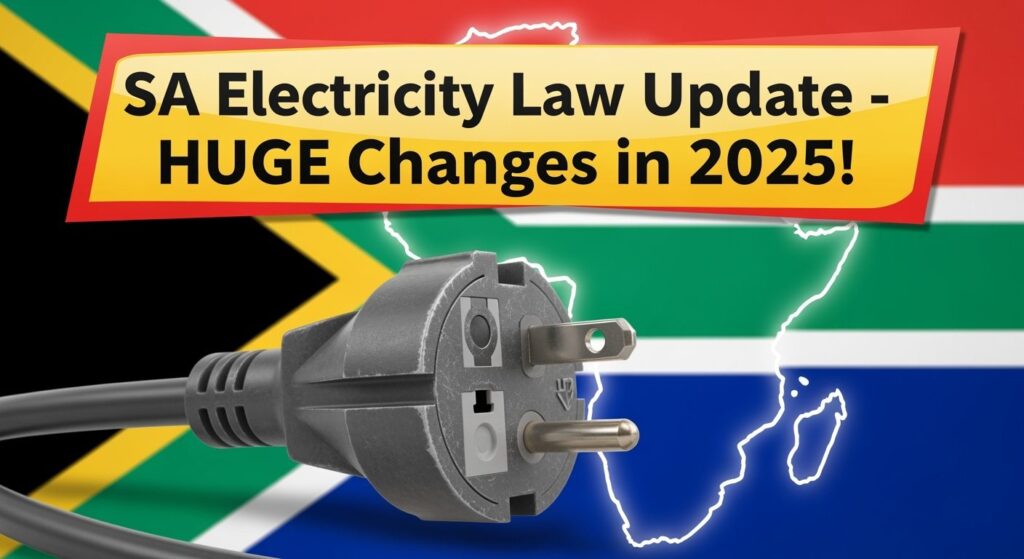South Africa Electricity Laws: As October 2025 approaches, significant changes to South Africa’s electricity regulations are set to take effect, and I want to make sure you’re fully prepared for what’s coming. These new electricity laws will impact everything from how you consume power to what you pay for it. Whether you’re a homeowner, business owner, or renter, understanding these regulatory updates is crucial for managing your energy costs and compliance requirements. Have you considered how these changes might affect your monthly budget or your long-term energy planning?

What Are The New Electricity Regulations?
The South Africa Electricity Law Update introduces a comprehensive overhaul of the existing power framework. The legislation focuses on decentralizing the electricity supply chain, allowing for more independent power producers to enter the market. This marks a significant shift from the previous Eskom-dominated model toward a more competitive environment. You’ll notice new provisions for renewable energy integration, with specific quotas for solar, wind, and hydroelectric contributions to the national grid.
Additionally, the updated regulations establish a tiered pricing structure based on consumption levels rather than the flat-rate system many South Africans have grown accustomed to. Smart metering becomes mandatory for all properties by March 2026, giving you approximately five months from the October implementation to make necessary installations. The regulatory body has also introduced stricter penalties for non-compliance, particularly regarding unauthorized connections and meter tampering.
Why These Changes Matter To Consumers
These South Africa electricity laws represent more than just administrative changes—they directly impact your daily life and financial planning. First, the new competitive market structure should theoretically lead to more reliable power supply, potentially reducing the load-shedding incidents that have plagued the country for years. For you as a consumer, this means fewer disruptions to your business operations or home life.
The tiered pricing model will reward energy efficiency, potentially lowering bills for conscious consumers while increasing costs for high-usage households and businesses. This creates a financial incentive for you to invest in energy-efficient appliances and systems. Furthermore, the regulations include new consumer protection clauses, giving you more recourse in disputes with energy providers. The environmental impact shouldn’t be overlooked either—these changes align with global climate commitments and may improve South Africa’s carbon footprint over time.
- Lower tariffs for households consuming under 350kWh monthly
- Tax incentives for installing solar panels and battery systems
- Simplified process for selling excess power back to the grid
- Mandatory energy efficiency certificates for property sales after January 2026
How To Prepare For The October 2025 Implementation
I recommend starting your preparation well before the October deadline. Begin by conducting an energy audit of your property to understand your current consumption patterns. This baseline will help you identify where adjustments might be needed under the new tiered pricing structure. If you’re a business owner, consider consulting with an energy specialist who understands the new South Africa electricity laws and can provide tailored advice.
For homeowners, now is an ideal time to explore renewable energy options. The new regulations include significant incentives for solar installation, with tax rebates covering up to 25% of system costs. Don’t forget to budget for smart meter installation if your property doesn’t already have one. The government has published an official preparation checklist on their energy department website, which I strongly suggest you review for specific compliance requirements relevant to your situation.
When Will You See The Financial Impact?
While the laws take effect in October 2025, the financial implications will roll out in phases. You’ll likely see the first changes on your November 2025 electricity bill, which will reflect the new tiered pricing structure. The full economic impact, however, may take 6-12 months to materialize as market competition develops and renewable incentives begin to influence consumer behavior.
If you’ve invested in renewable energy systems, expect to see return on investment calculations shifting favorably under the new feed-in tariff rates. For businesses, the quarterly tax filing for January 2026 will be the first opportunity to claim new energy efficiency tax credits. Budget-conscious consumers should note that the government has announced a six-month transition assistance program for low-income households, which you can apply for starting September 2025 if you meet the eligibility criteria.
Real-World Impact Example
Consider the case of the Naidoo family in Cape Town, who recently installed a 5kW solar system with battery backup. Under the current regulations, their system saves them approximately R1,500 monthly. With the October 2025 electricity law updates, their savings are projected to increase to R2,700 monthly due to the new feed-in tariff rates and peak-usage pricing structure. Additionally, they’ll qualify for a R15,000 tax rebate on their installation costs—a benefit unavailable under the current framework. Their case demonstrates how proactive adaptation to the new regulations can transform what might seem like a regulatory burden into a financial opportunity.








